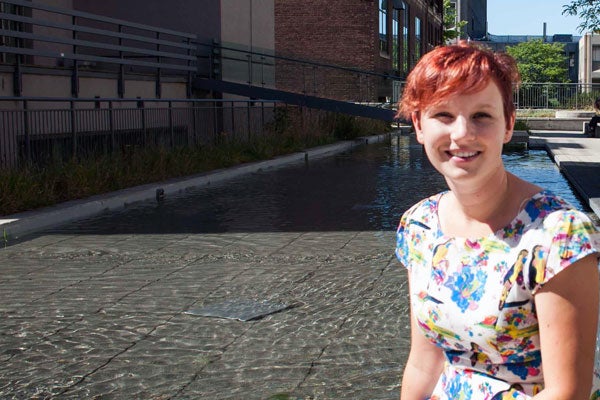
Water: are we doing enough to conserve and protect this resource?
Published: September 12, 2014
The University of Toronto is home to many experts who study how cities can be improved. One aspect of cities that may be taken for granted is one of the most important: water supply.
At U of T, water conservation efforts have been underway since the 1970s. For example, underground cisterns on the downtown campus collect rainwater, which is then used by a smart irrigation system that only waters lawns if there is no rain in the forecast. (Read more about water conservation at U of T.) But as cities continue to grow, so does the need for everyone to protect and manage water resources.
Enter Jennifer Drake, a professor with the University of Toronto’s civil engineering department and an expert in water security.
Drake’s research expertise includes stormwater systems, watershed planning and stormwater management. She’s especially passionate about building and managing urban water systems that minimize the impact on the natural environment.
The increasing frequency of extreme weather events such as droughts and floods is drawing attention to Drake’s research and the challenges and opportunities of protecting urban water resources in the 21st century. Writer Dominic Ali spoke with Drake about the importance of water for cities in the 21st century.
Why is water management so important?
We only have a finite amount of water and it is cycled in the environment over and over again. This means that no matter where you are, the water in the natural environment will be used by someone for drinking, irrigation, recreation, etc. Water security includes issues of availability and water quality.
My research focuses on issues of quantity such as flooding (i.e., protecting us from when there is too much water) and quality such as developing new technologies to improve the quantity of urban runoff before it is returned to a natural system like a creek or lake.
Canada’s infrastructure deficit is estimated at $123 billion of which $31 billion is for water/wastewater. Improvements to water infrastructure are critical to the Canadian economy. Moreover, when we invest in our water resources and foster healthy aquatic environments we make our cities more liveable and create opportunities for residents to experience the beauty and peace of the natural environment.
Why is low-impact development seen as better for water management?
Our water resources are much more resilient and secure when we work with nature instead of against it. For example, if you live in the U.S. southwest, a region of water scarcity, your lawn should be landscaped with drought-resistant plants, not turf grass. In Ontario, low-impact development practices aim to restore the hydrology that is often lost as a result of urbanization. This is achieved through innovative technologies like green roofs, bioretention systems and permeable pavements.
What are some of the water challenges faced by cities?
One of the biggest challenges facing cities like Toronto is the uncertainty regarding water availability in the future. All of our economic and social systems depend on reliable source waters (groundwater, lakes, rivers and streams) with sufficient quantity and quality. Not only do we require water for drinking and recreation but all agricultural, manufacturing and resource-based industries require secure water supplies, too.
Climate change will alter the availability of water at local and national levels. Cities need to invest in infrastructure which improves our resilience during extreme weather. In Ontario it is anticipated that climate change will change the type (snow vs. rain) and timing of precipitation. To adapt to climate change infrastructure investment, replacement and maintenance will be essential for cities. Some cities, such as Kitchener and Mississauga, are already adapting by developing new revenue mechanisms to support these costs.
With a Toronto election coming up, what question would you pose to the candidates about water security?
Toronto has implemented some very progressive programs such as the Green Roof Bylaw and the Mandatory Downspout Disconnection Program that are aimed at reducing flooding and improving water quality. However, despite these actions, flooding continues to affect Torontonians quite regularly.
From the mayoral candidates I would like to know what programs they would advance to continue reducing the occurrence of flooding within the city and minimizing the impact of flooding on Torontonians.
What first attracted you to this field?
I first became interested in urban water management and water security as an undergraduate student during a summer co-op placement with the City of Burlington. I observed first-hand the challenges associated with managing water infrastructure. This inspired me to ultimately research water security.
One of my tasks was to research maintenance costs for stormwater management pond cleaning. I was amazed to discover that, at the time, Ontario’s municipalities had invested in ponds for flood and water quality control but did not have sufficient funds to conduct the cleaning projects that need to be completed every 10 to 15 years.
This issue became even more compelling when I realized that a mid-sized Ontario municipality may operate 50 to 100 ponds and a single cleaning project could cost over $500,000.
Are any cities doing innovative things to improve water security?
There are a surprising number of success stories. Las Vegas, a city more famous for excess than conservation, is a great example. While the population of Las Vegas has tripled over the last 20 years its per capita, water use has dropped by 31 per cent. This means that the total water used today is almost the same as it was 20 years ago. Las Vegas has achieved this through changing water rates, supporting conservation and investing the infrastructure to allow for water re-use.



